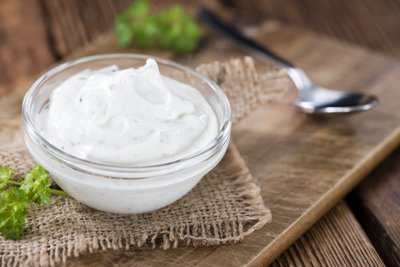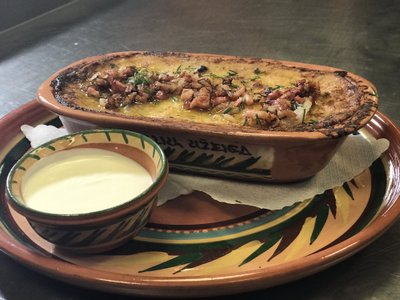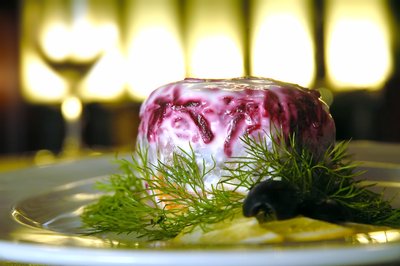Kūčiukai
Before we dig into the dough, here’s a pinch of Lithuanian culture. In Lithuania, Christmas Eve, not Christmas is the most important family gathering of the year. The table is traditionally meat-free and features at least 12 dishes (after the 12 disciples of Christ). One of the tiniest, yet most quintessential to the table is the tiny cookie called Kūčiukas. Little pieces of yeast batter are sprinkled with poppy seeds and baked in the oven for 10 minutes. This way you get a whole jar of crispy bits of happiness. Pour milk over them and eat it like a soup (that’s right – cookie soup), you’ll definitely love it!

You will need:
500 g all-purpose flour
250 ml milk
20 g fresh yeast
100 g sugar
a pinch of salt
2 tbsp of oil
50 g poppy seeds
Preparation:
Sift the flour.
Heat up the milk to room temperature. Mix the yeast with a pinch of sugar and a spoon of milk.
Whip the rest of the milk with salt, sugar and oil. Add in the yeast and stir well.
Pour a little less than half of the flour and mix. Cover the lid and leave in a warm place for half an hour.
Add the rest of the flour and poppy seeds into the rested batter. Knead the batter for at least 5 minutes until it is soft and shiny. Then leave it covered for another 1-1.5 hours.
Knead the batter again, pushing the air out of it. Roll small balls and put them onto an oil-covered tin-plate.
Heat up the oven to 190 °C and bake for around 10 minutes.
Baked kūčiukai should be left to cool and kept safe until Christmas Eve (you can have a handful while no one’s looking, we won’t tell).
Kastinys
Britons have their gravy, Swedes put cranberry sauce on virtually everything, but Lithuanians have a condiment to rival both – the one and only creamy kastinys. You’ll never eat baked potato any other way when you try it with this deliciousness. Long story short – it’s a savoury cream dip made with sour cream, butter, garlic and dill. Delightfully light, full of taste, ready to brighten up any plate on your Christmas table. Best enjoyed spread on rye bread or with hot kugel, latkes or some other potato-based dish.

You will need:
380 g of sour cream
100 g of butter
1 bundle of dill
3 cloves of garlic
1 pinch of salt
Preparation:
First put the butter into a bowl and mash it with a wooden spoon.
Then goes the sour cream spoon by spoon, mixing continuously. When the sauce becomes even, more should be added.
If chunks of butter are visible during the mixing process, the bowl can be put over a pot of boiling water, having the steam do the heating. Don’t stop stirring until the pieces are gone.
Lastly, add garlic, dill and salt. Mix well one last time. Voila!
Kugelis
If you’re all about that silky goodness with a twist of crispiness, check out this beauty called kugelis, known as kugel outside of Lithuania. An absolute favourite dinner choice in wintertime. Kugelis is basically grated potatoes and eggs, baked until golden, garnished with sizzling bacon and sour cream. Considering the love that Lithuanians have for potatoes, this dish could be called their version of lasagna. Its warmth and cosiness are completely irresistible.

You will need:
1 egg
2 kg of potatoes
2 onions
200 g of bacon
400 ml of milk
2 tsp of salt
0.5 tsp of pepper
2-3 laurel leaves
vegetable oil to grease the pan
butter to soften the top (if you wish),
200-300 g extras for the filling, not mandatory (chicken, meat, cottage cheese, mushrooms)
Preparation:
1. Prepare the extra ingredients, if you use them. Cut raw chicken, meat or mushrooms into small pieces and fry them in a pan.
2. Cut bacon and onions into little cubes and fry in a pan as well. Peel the potatoes and grate them with a fine grater. If it seems not starchy enough, beat one egg in.
3. Mix grated potatoes with fried bacon, onions and other additives. Garnish with spices.
4. Heat the milk, but don’t bring it to boil. Pour it into the mixture, while continuously stirring.
5. Oil a deep baking dish generously. Lay the meat or chicken on the base, if you choose to use them. Pour in the potato mix. Smooth out the top.
6. Bake at 180-200 °C in in an oven for around 1-1.5 hour. Check the texture from time to time, it should become stiff.
7. Ten minutes before pulling kugelis out of the oven, lay a few pieces of butter on top. Serve with a sauce of your choice. Sour cream and bacon recommended, a sprinkle of spring onions as well.
Šakotis
No Christmas would be complete without a Christmas Tree. That’s exactly how one of the most popular Lithuanian cakes look like. Standing proud in the centre of the table, the famous tree-cake takes the scene. This dessert of brittle texture and sugary flavour is broken by hands and then eaten. Sharing is caring, and nothing says sharing better than Šakotis.

You’ll need an open fire to bake one by yourself. Often referred to as spit-cake, Šakotis is baked by pouring batter on a spit spun over flames (much like a shish kebab). There’s plenty of workshops across Lithuania that will help you master the art of Šakotis baking and a whole museum dedicated to it. Definitely a must if you plan to hop on a plane to Lithuania.
Meduolis
If Christmas had a smell, it would be that of gingerbread. Everyone around the world bakes it, and Lithuanians have their version as well. Meduolis is a soft cake with an unforgettable aroma. The smell of cinnamon, cloves and oranges lingers in the air whenever this squishy goodness is around. Its rich texture created by rye flour and honey can make anyone swoon. Think of it as a healthier muffin alternative! Treat yourself without any guilt this holiday season.

You will need:
100 g of butter
180 g of sugar
1 tsp of vanilla sugar
2 eggs
150 g of honey
120 g of sour cream
300-400 g of rye flour
1 tsp of bitter cacao powder
2-3 tsp of aromatic pepper, cloves, coriander, cinnamon, nutmeg and orange peel crushed and mixed together.
Preparation:
Melt the butter, mix it with sugar, put in two egg yolks, melted honey, sour cream, mix everything well.
Put in the flour and baking powder.
Pour cacao and the spices.
Whip the egg whites to a foam and carefully pour them in. The batter doesn’t have to be to be too runny or too hard.
Bake in an oven pre-heated to 150 degrees Celsius for an hour. You’ll know it’s ready when the smell of Christmas itself hits your nostrils!
Tinginys
The king of all Lithuanian desserts, tinginys is the best Christmas gift to those sweet tooth friends of yours. It’s incredibly easy to make, hence the name that means “lazy boy”. So, if the recipes above seem too complicated for you, go with tinginys. Even though it is enjoyed all throughout the year, tinginys goes particularly well with hot tea or coffee in the winter. Just be careful and don’t eat it whole in one sitting, Lithuanians are often guilty of that.

You will need:
500 g of sweet biscuits (Lithuanian Gaidelis is the best for this, trust us)
1 can of sweet condensed milk
200 g of butter
5 tbsp of cocoa
Preparation:
Break the biscuits into small chunks with your hands. No need to overdo it – you’ll want chunks, not crumbs.
In a pot, melt the butter and mix it with condensed milk and cocoa.
Pour the mixture over the cookie chunks and mix everything thoroughly.
Pour the tinginys-in-the-making on baking paper and roll it to form a sweet sausage.
Let the tinginys cool to room temperature, cover it with food wrap and let sit lazily in the fridge for the night. It’s that easy!
Herring Salad
If you ever asked a Lithuanian what strikes his mind whenever Christmas Eve is mentioned, one cold dish would be an instant answer. Herring salads of vivid colours dominate the table in all their glory. Made with fresh apples, boiled potatoes, sweet beets, a generous serving of mayo and the queen herring itself. These sweet and sour creations are an absolute delight to the taste buds. And their variations are endless! One of the classic ones can be made with this recipe below.

You will need:
4 herring fillets (or two whole herrings)
2 carrots
1 apple
2 beets
2 potatoes
100 g mayonnaise
3 tbsp cooking oil
1 tsp honey
salt and pepper
herbs (parsley, dill) for garnish
Preparation:
Boil the unpeeled potatoes and carrots in a pot of salted water.
Wash the beets, wrap them in foil, put them on an oven pan or rack, and bake at 180 °C. They will need one to two hours, depending on their size. Check them with a fork to make sure they’re soft.
Peel the cooled vegetables (potatoes, carrots and beets) and grate them separately.
Heat a splash of oil in a medium-sized pan. Add the carrots and season them with salt and pepper. Add the honey, mix and fry briefly to caramelize the honey. The carrots should be shiny. Let them cool.
Cut the herring fillets up any way you like. Bite-size pieces work best.
Grate the apple.
Lay the herring pieces down on a dish. Follow with layers of the remaining ingredients in this order: carrot, potato, salt and pepper, apple, mayonnaise, and beets. Sprinkle with herbs to serve.
